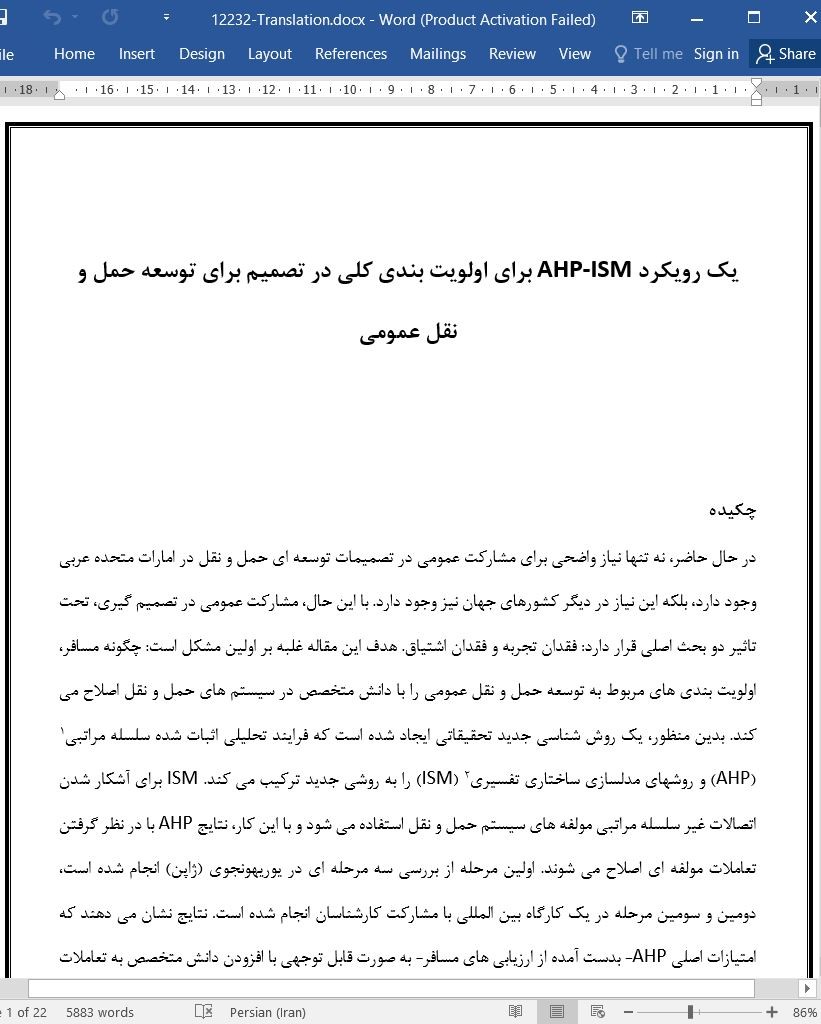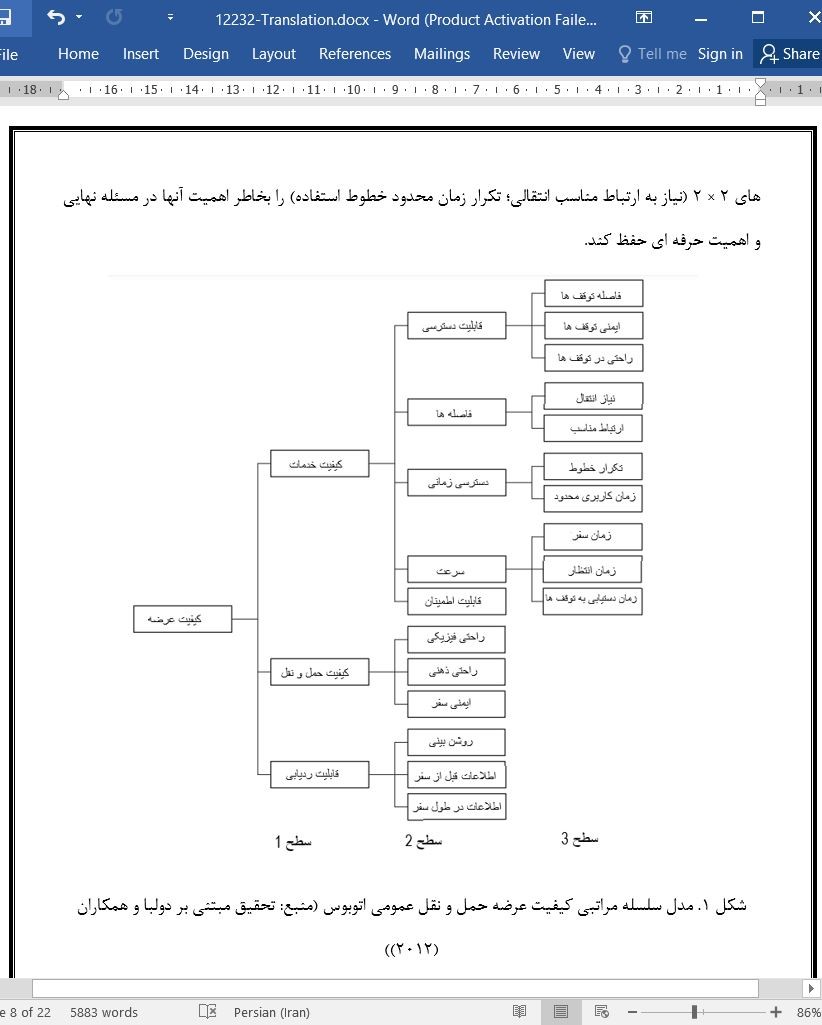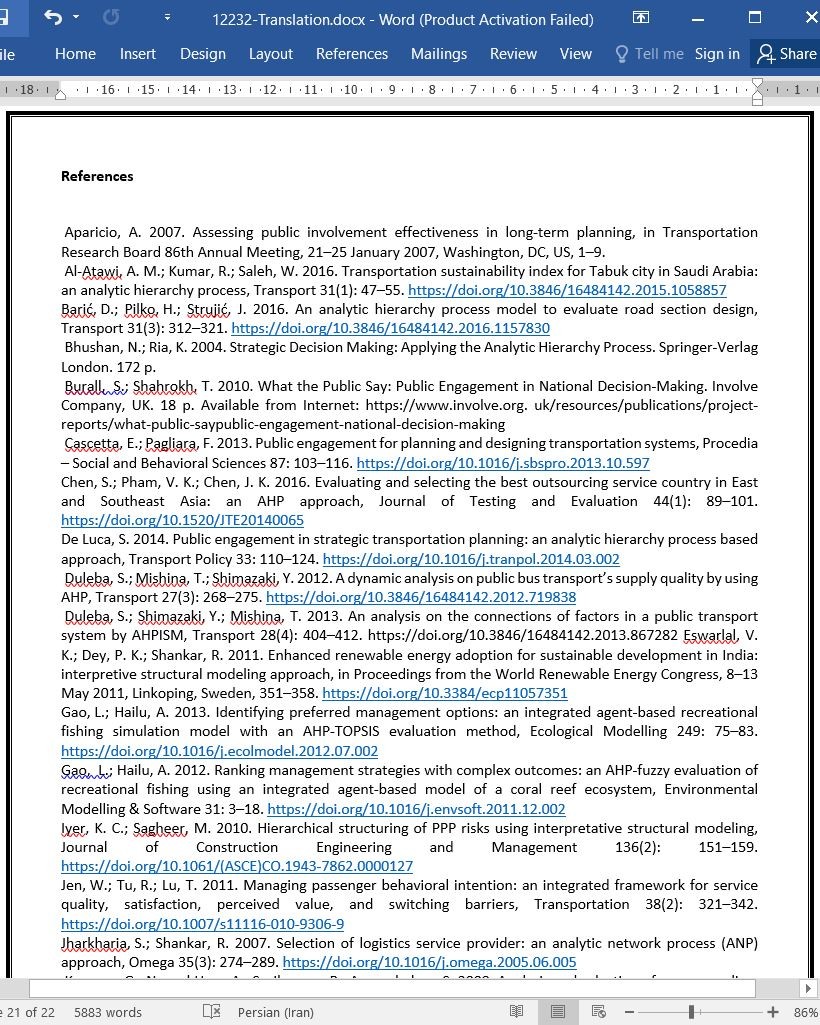
یک رویکرد AHP-ISM برای اولویت بندی کلی در تصمیم برای توسعه حمل و نقل عمومی
چکیده
در حال حاضر، نه تنها نیاز واضحی برای مشارکت عمومی در تصمیمات توسعه ای حمل و نقل در امارات متحده عربی وجود دارد، بلکه این نیاز در دیگر کشورهای جهان نیز وجود دارد. با این حال، مشارکت عمومی در تصمیم گیری، تحت تاثیر دو بحث اصلی قرار دارد: فقدان تجربه و فقدان اشتیاق. هدف این مقاله غلبه بر اولین مشکل است: چگونه مسافر، اولویت بندی های مربوط به توسعه حمل و نقل عمومی را با دانش متخصص در سیستم های حمل و نقل اصلاح می کند. بدین منظور، یک روش شناسی جدید تحقیقاتی ایجاد شده است که فرایند تحلیلی اثبات شده سلسله مراتبی (AHP) و روشهای مدلسازی ساختاری تفسیری (ISM) را به روشی جدید ترکیب می کند. ISM برای آشکار شدن اتصالات غیر سلسله مراتبی مولفه های سیستم حمل و نقل استفاده می شود و با این کار، نتایج AHP با در نظر گرفتن تعاملات مولفه ای اصلاح می شوند. اولین مرحله از بررسی سه مرحله ای در یوریهونجوی (ژاپن) انجام شده است، دومین و سومین مرحله در یک کارگاه بین المللی با مشارکت کارشناسان انجام شده است. نتایج نشان می دهند که امتیازات اصلی AHP- بدست آمده از ارزیابی های مسافر- به صورت قابل توجهی با افزودن دانش متخصص به تعاملات عامل اصلاح می شوند، بنابراین ترتیب جدید اولویت بندی مرتبط با اهمیت توسعه مولفه های سیستم حمل و نقل عمومی حاصل می شود. روش معرفی شده را می توان برای شرایط تصمیم گیری بهبود دیگر سیستم های حمل و نقل استفاده کرد که در آن مشارکت مسافر نیاز است.
مقدمه
در دهه اخیر، اهمیت روزافزون مشارکت در تصمیم گیری حمل و نقل عمومی نشان داده شده است. خود مفهوم را می توان به صورت «مشارکت در تصمیم گیری با هدف تاثیرگذاری انتخاب (ها)ی انجام شده» (رن و همکاران، 1995) تعریف کرد. مشارکت عمومی نه تنها به بخشی از قانون گذاری تبدیل شده است- بعنوان مثال، قانون دارایی خالص حمل و نقل کارآمد، انعطاف پذیر، پاسخگو، ایمن- دولت ایالات متحده (2005)- بلکه میزان تلاش مطالعات موردی برای تقاضای افکار عمومی نیز در حال افزایش است (در میان مطالعات دیگر، مطالعات بیان شده توسط آپاریسیو (2007)؛ کاسکتا و پاگلیارا (2013) و دی لوکا (2014) را مشاهده کنید). تعداد دستورالعمل ها و کتابچه های مرتبط در حال افزایش هستند- بعنوان مثال، راهنمای تصمیم گیری حمل و نقل- DoT ایالات متحده (2015). بورال و شاهرخ (2010)، 9 توصیه را در مورد این موضوع ارائه می کنند که چگونه عموم مردم در این فرایندهای تصمیم گیری مشارکت می کنند؛ در این میان، دیگران نیز اظهار داشتند که « دولت باید مسئولیت نهایی برای تصمیمات سیاست متوازن و منصفانه را در نظر بگیرد که از طریق گفتگو با مردم از آن آگاه می شوند».
Abstract
Recently, there has been a transparent need to involve public in transport development decisions not only in the EU but also in other countries worldwide. Public involvement in decision-making, however, suffers from two critical issues: lack of expertise and lack of enthusiasm. This paper aims to overcome the first problem: how to amend passenger preferences related to public transport development with expert knowledge on transport systems. For this purpose, a new research methodology has been created which combines the well proven Analytic Hierarchy Process (AHP) and Interpretive Structural Modelling (ISM) methods in a novel way. ISM is used to reveal the non-hierarchical connections of the transport system elements and by this, AHP results are modified with the consideration of element interactions. The first stage of the three-stage-survey has been conducted in Yurihonjo (Japan), the second and third in an international workshop with the participation of experts. Results show that the original AHP scores – gained from passenger evaluations – are significantly modified by adding expert knowledge on factor interactions, thus new preference order is gained related to the importance of the development of public transport system elements. The introduced procedure can be applied for other public transport system improvement decision-making situations in which passenger involvement is required.
Introduction
The recent decades have shown the growing importance of public engagement in transportation decision-making. The notion itself can be defined as “involvement in decision-making with the purpose of influencing the choice(s) being made” (Renn et al. 1995). Public participation has not only become part of legislation – e.g. the Safe, Accountable, Flexible, Efficient Transportation Equity Act: a Legacy for Users – US Government (2005) – but the amount of case studies attempting to solicit public opinion has also been increasing (see among others the developments described by Aparicio (2007); Cascetta and Pagliara (2013) and De Luca (2014). The number of connected guidelines and booklets are also growing – e.g. A Guide to Transportation Decisionmaking – US DoT (2015). Burall and Shahrokh (2010) present nine recommendations on how to engage the public in these decision making processes; among others also declaring that “government must take final responsibility for making fair and balanced policy decisions that are informed by dialogue with the public”.
چکیده
مقدمه
1. مرور ادبیات
2.روش شناسی
3.نتایج بررسی مبتنی بر مدل ایجاد شده
4.مرحله AHP
5. نتایج ISM
6. نتایج پس از اصلاح امتیاز بندی AHP
نتیجه گیری ها
منابع
Abstract
Introduction
1. Literature review
2. Methodology
3. Results of the survey based on the created model
4. AHP stage
5. ISM results
6. Results after modifying the AHP scoring
Conclusions
References
- ترجمه فارسی مقاله با فرمت ورد (word) با قابلیت ویرایش، بدون آرم سایت ای ترجمه
- ترجمه فارسی مقاله با فرمت pdf، بدون آرم سایت ای ترجمه



